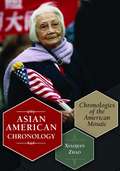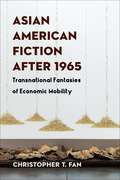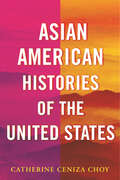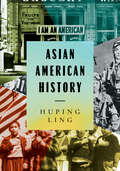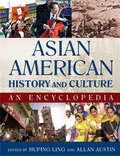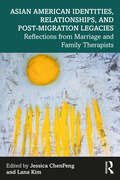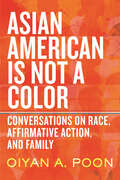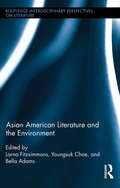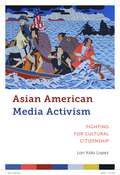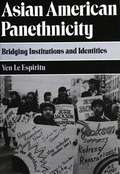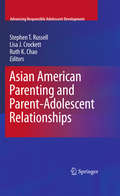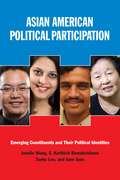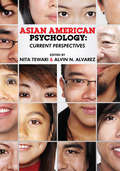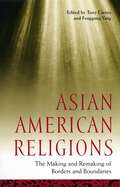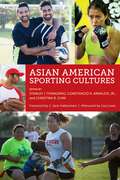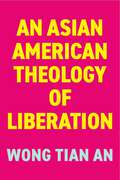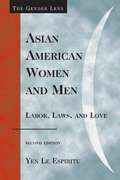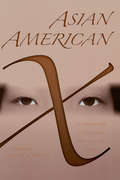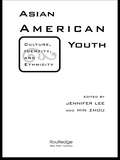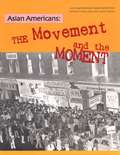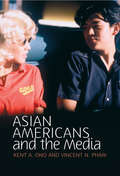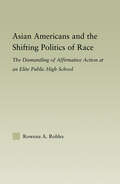- Table View
- List View
Asian American Chronology: Chronologies Of The American Mosaic
by Xiaojian ZhaoFrom Filipino labor strikes to Japanese baseball players in the major leagues, this accessible volume presents the most influential events in Asian American history--as well as several key moments that have remained under the historical radar.
Asian American Dreams: The Emergence Of An American People
by Helen Zia<P><P>This groundbreaking book is about the transformation of Asian Americans from a few small, disconnected, and largely invisible ethnic groups into a self-identified racial group that is influencing every aspect of American society. It explores the junctures that shocked Asian Americans into motion and shaped a new consciousness, including the murder of Vincent Chin, a Chinese American, by two white autoworkers who believed he was Japanese; the apartheid-like working conditions of Filipinos in the Alaska canneries; the boycott of Korean American greengrocers in Brooklyn; the Los Angeles riots; and the casting of non-Asians in the Broadway musical Miss Saigon. The book also examines the rampant stereotypes of Asian Americans. <P><P> Helen Zia, the daughter of Chinese immigrants, was born in the 1950s when there were only 150,000 Chinese Americans in the entire country, and she writes as a personal witness to the dramatic changes involving Asian Americans. <P><P> Written for both Asian Americans—the fastest-growing population in the United States—and non-Asians, Asian American Dreams argues that America can no longer afford to ignore these emergent, vital, and singular American people.
Asian American Fiction After 1965: Transnational Fantasies of Economic Mobility
by Christopher T. FanAfter the 1965 Immigration and Nationality Act loosened discriminatory restrictions, people from Northeast Asian countries such as South Korea, Taiwan, Japan, and eventually China immigrated to the United States in large numbers. Highly skilled Asian immigrants flocked to professional-managerial occupations, especially in science, technology, engineering, and math. Asian American literature is now overwhelmingly defined by this generation’s children, who often struggled with parental and social expectations that they would pursue lucrative careers on their way to becoming writers.Christopher T. Fan offers a new way to understand Asian American fiction through the lens of the class and race formations that shaped its authors both in the United States and in Northeast Asia. In readings of writers including Ted Chiang, Chang-rae Lee, Ken Liu, Ling Ma, Ruth Ozeki, Kathy Wang, and Charles Yu, he examines how Asian American fiction maps the immigrant narrative of intergenerational conflict onto the “two cultures” conflict between the arts and sciences. Fan argues that the self-consciousness found in these writers’ works is a legacy of Japanese and American modernization projects that emphasized technical and scientific skills in service of rapid industrialization. He considers Asian American writers’ attraction to science fiction, the figure of the engineer and notions of the “postracial,” modernization theory and time travel, and what happens when the dream of a stable professional identity encounters the realities of deprofessionalization and proletarianization. Through a transnational and historical-materialist approach, this groundbreaking book illuminates what makes texts and authors “Asian American.”
Asian American Histories of the United States (REVISIONING HISTORY)
by Catherine Ceniza ChoyAn inclusive and landmark history, emphasizing how essential Asian American experiences are to any understanding of US historyOriginal and expansive, Asian American Histories of the United States is a nearly 200-year history of Asian migration, labor, and community formation in the US. Reckoning with the onset of the COVID-19 pandemic and the surge in anti-Asian hate and violence, award-winning historian Catherine Ceniza Choy presents an urgent social history of the fastest growing group of Americans. The book features the lived experiences and diverse voices of immigrants, refugees, US-born Asian Americans, multiracial Americans, and workers from industries spanning agriculture to healthcare.Despite significant Asian American breakthroughs in American politics, arts, and popular culture in the 21st century, a profound lack of understanding of Asian American history permeates American culture. Choy traces how anti-Asian violence and its intersection with misogyny and other forms of hatred, the erasure of Asian American experiences and contributions, and Asian American resistance to what has been omitted are prominent themes in Asian American history. This ambitious book is fundamental to understanding the American experience and its existential crises of the early 21st century.
Asian American History: An Encyclopedia (Asian American Studies Today)
by Huping LingA comprehensive survey, Asian American History places Asian immigration to America in international and domestic contexts, and explores the significant elements that define Asian America: imperialism and global capitalist expansion, labor and capital, race and ethnicity, immigration and exclusion, family and work, community and gender roles, assimilation and multiculturalism, panethnicity and identity, transnationalism and globalization, and new challenges and opportunities. It is an up-to-date and easily accessible resource for high school and college students, as well as anyone who is interested in Asian American history. Asian American History: Covers the major and minor Asian American ethnic groups. It presents the myriad and poignant stories of a diverse body of Asian Americans, from illiterate immigrants to influential individuals, within a broad and comparative framework, offering microscopic narratives as well as macroscopic analysis and overviews. Utilizes both primary and secondary sources, employs data and surveys, and incorporates most recent scholarly discourses. Attractive and accessible by incorporating voices and illustrations of the contemporaries and by using straightforward language and concise syntax, while maintaining a reasonable level of scholarly depth. Special features: Each chapter features Significant Events, Sidebars incorporating primary sources or scholarly debates, Review Questions, and Further Readings to aid and enhance student learning experience. Bibliographies, charts, maps, photographs and tables are included. Written by a preeminent historian with four decades of teaching, research, and publishing experiences in Asian American history, it is the best book on the subject to date.
Asian American History and Culture: An Encyclopedia
by Huping Ling Allan W. AustinWith overview essays and more than 400 A-Z entries, this exhaustive encyclopedia documents the history of Asians in America from earliest contact to the present day. Organized topically by group, with an in-depth overview essay on each group, the encyclopedia examines the myriad ethnic groups and histories that make up the Asian American population in the United States. "Asian American History and Culture" covers the political, social, and cultural history of immigrants from East Asia, Southeast Asia, South Asia, the Pacific Islands, and their descendants, as well as the social and cultural issues faced by Asian American communities, families, and individuals in contemporary society. In addition to entries on various groups and cultures, the encyclopedia also includes articles on general topics such as parenting and child rearing, assimilation and acculturation, business, education, and literature. More than 100 images round out the set.
Asian American Identities, Relationships, and Post-Migration Legacies: Reflections from Marriage and Family Therapists
by Jessica ChenFeng and Lana KimBringing together the personal and professional narratives of Asian American family therapists, this book offers insight into the Asian American experience through systemic theory and frameworks, individual and community stories, and clinical considerations.The Asian American experience is still a largely invisible and unknown one, especially in the field of marriage and family therapy. With a contextual lens, this book highlights how understanding family migration legacies and individual generational status relative to time, place, and context is critical to doing meaningful work with Asian Americans. Filled with thought-provoking case studies and reflective questions, chapters discuss the impact of stereotyping on mental health; the historical and present ways that Asian American racialization invisibilizes individual and collective experiences; shame associated with bicultural identity, gender, generational trauma, media representations; and more. Each chapter bridges these ideas to clinical practice while concurrently centering the voices and experiences of Asian American therapists.This book is essential reading for marriage and family therapists and other mental health clinicians who want to deepen their understanding of, relationship with, and clinical support for the Asian Americans in their lives, whether friends, colleagues, supervisees, or clients.
Asian American Is Not a Color: Conversations on Race, Affirmative Action, and Family
by OiYan A. PoonA mother and race scholar seeks to answer her daughter&’s many questions about race and racism with an earnest exploration into race relations and affirmative action from the perspectives of Asian AmericansBefore being struck down by the US Supreme Court in June 2023, affirmative action remained one of the few remaining policy tools to address racial inequalities, revealing the peculiar contours of racism and anti-racist strategies in America. Through personal reflective essays for and about her daughter, OiYan Poon looks at how the debate over affirmative action reveals the divergent ways Asian Americans conceive of their identity. With moving sincerity and insightful study, Poon combines extensive research with personal narratives from both herself and a diverse swath of individuals across the Asian American community to reflect on and respond to her daughter&’s central question: What does it mean to be Asian American?Poon conducts interviews with Asian Americans throughout the US who have been actively engaged in policy debates over race-conscious admissions or affirmative action. Through these exchanges, she finds that Asian American identity remains deeply unsettled in a contest between those invested in reaching the top of the racial hierarchy alongside whiteness and those working toward a vision of justice and humanity co-constructed through cross-racial solidarity.Poon uses these contrasting viewpoints to guide her conversations with her daughter, providing a heartfelt and optimistic look at how understanding the diversity and nuances of the Asian American experience can help us envision a more equitable future.
Asian American Literature and the Environment (Routledge Interdisciplinary Perspectives on Literature)
by Lorna Fitzsimmons Youngsuk Chae Bella AdamsThis book is a ground-breaking transnational study of representations of the environment in Asian American literature. Extending and renewing Asian American studies and ecocriticism by drawing the two fields into deeper dialogue, it brings Asian American writers to the center of ecocritical studies. This collection demonstrates the distinctiveness of Asian American writers’ positions on topics of major concern today: environmental justice, identity and the land, war environments, consumption, urban environments, and the environment and creativity. Represented authors include Amy Tan, Maxine Hong Kingston, Ruth Ozeki, Ha Jin, Fae Myenne Ng, Le Ly Hayslip, Lan Cao, Mitsuye Yamada, Lawson Fusao Inada, Jeanne Wakatsuki Houston, Milton Murayama, Don Lee, and Hisaye Yamamoto. These writers provide a range of perspectives on the historical, social, psychological, economic, philosophical, and aesthetic responses of Asian Americans to the environment conceived in relation to labor, racism, immigration, domesticity, global capitalism, relocation, pollution, violence, and religion. Contributors apply a diversity of critical frameworks, including critical radical race studies, counter-memory studies, ecofeminism, and geomantic criticism. The book presents a compelling and timely "green" perspective through which to understand key works of Asian American literature and leads the field of ecocriticism into neglected terrain.
Asian American Media Activism: Fighting for Cultural Citizenship (Critical Cultural Communication #10)
by Lori Kido LopezChoice Top 25 Academic TitleHow activists and minority communities use media to facilitate social change and achieve cultural citizenship. Among the most well-known YouTubers are a cadre of talented Asian American performers, including comedian Ryan Higa and makeup artist Michelle Phan. Yet beneath the sheen of these online success stories lies a problem—Asian Americans remain sorely underrepresented in mainstream film and television. When they do appear on screen, they are often relegated to demeaning stereotypes such as the comical foreigner, the sexy girlfriend, or the martial arts villain. The story that remains untold is that as long as these inequities have existed, Asian Americans have been fighting back—joining together to protest offensive imagery, support Asian American actors and industry workers, and make their voices heard. Providing a cultural history and ethnography, Asian American Media Activism assesses everything from grassroots collectives in the 1970s up to contemporary engagements by fan groups, advertising agencies, and users on YouTube and Twitter. In linking these different forms of activism, Lori Kido Lopez investigates how Asian American media activism takes place and evaluates what kinds of interventions are most effective. Ultimately, Lopez finds that activists must be understood as fighting for cultural citizenship, a deeper sense of belonging and acceptance within a nation that has long rejected them.
The Asian American Movement
by William WeiActive for more than two decades, the Asian American movement began a middle-class reform effort to achieve racial equality, social justice, and political empowerment. In this first history and in-depth analysis of the Movement, William Wei traces to the late 1960s, the genesis of an Asian American identity, culture, and activism. Wei analyzes the Asian American women's movement, the alternative press, Asian American involvement in electoral politics. Interviews with many key participants in the Movement and photographs of Asian American demonstrations and events enliven this portrayal of the Movement's development, breadth, and conflicts.
Asian American Panethnicity: Bridging Institutions and Identities
by Espiritu Yen LeWith different histories, cultures, languages, and identities, most Americans of Chinese, Japanese, Filipino, Korean, and Vietnamese origin are lumped together and viewed by other Americans simply as Asian Americans. Since the mid 1960s, however, these different Asian American groups have come together to promote and protect both their individual and their united interests. The first book to examine this particular subject, Asian American Panethnicity is a highly detailed case study of how, and with what success, diverse national-origin groups can come together as a new, enlarged panethnic group. Yen Le Espiritu explores the construction of large-scale affiliations, in which previously unrelated groups submerge their differences and assume a common identity. Making use of extensive interviews and statistical data, she examines how Asian panethnicity protects the rights and interests of all Asian American groups, including those, like the Vietnamese and Cambodians, which are less powerful and prominent than the Chinese and Japanese. By citing specific examples-educational discrimination, legal redress, anti-Asian violence, the development of Asian American Studies programs, social services, and affirmative action-the author demonstrates how Asian Americans came to understand that only by cooperating with each other would they succeed in fighting the racism they all faced. Author note: Yen Le Espiritu is Assistant Professor in the Department of Ethnic Studies at the University of California, San Diego.
Asian American Parenting and Parent-Adolescent Relationships (Advancing Responsible Adolescent Development)
by Stephen T. Russell Ruth K. Chao Lisa J. CrockettThe growing presence of non-European cultures in America brings new challenges to as well as opportunities for parenting research. Whereas particular constructs of parent-child relationships were once considered universal, we now recognize distinct cultural variations. This is especially true in the case of Asian Americans, a population encompassing many diverse ethnicities. Informed by a variety of qualitative and quantitative methodologies including detailed surveys of teenagers and their parents, Asian American Parenting and Parent-Adolescent Relationships focuses on Chinese and Filipino Americans--large populations with markedly different histories and cultural influences--giving readers a new lens into the nature and meaning of cultural differences in parenting. Synthesizing data on adolescent autonomy and dependence, parental support and control (both crucial to adolescents' wellbeing), and the rarely-explored concept of parental sacrifice, this ambitious volume: Compares the parental belief systems of European Americans and immigrant Chinese and their influence on parenting styles. Discusses the role of measurement equivalence in understanding Asian American parenting practices. Examines sacrifice as a central concept in Asian American parenting and in immigrant parenting in general. Analyzes how Asian American teenagers understand the support and control provided by their parents. Explores the dynamics of parent and child gender in Asian American parenting. Places these findings in the context of previous parenting research and identifies new directions for the field. Asian American Parenting and Parent-Adolescent Relationships is a uniquely informative reference for researchers, clinicians, and graduate students across multiple disciplines, including developmental, clinical child, and school psychology, sociology, and anthropology as well as ethnic and women's studies. "A much needed and extremely thoughtful contribution to the scholarship on Asian American families. The authors rely on a variety of research methods to reveal patterns that challenge stereotypes and urge us to move beyond pan ethnic categories and explore the rich diversity among Asian Americans. This book is an exemplary study of culture and parenting." (Niobe Way, President, Society for Research on Adolescence / Professor of Applied Psychology, New York University)
Asian American Political Participation: Emerging Constituents and Their Political Identities
by Jane Junn Janelle Wong S. Karthick Ramakrishnan Taeku LeeAsian Americans are a small percentage of the U.S. population, but their numbers are steadily rising—from less than a million in 1960 to more than 15 million today. They are also a remarkably diverse population—representing several ethnicities, religions, and languages—and they enjoy higher levels of education and income than any other U.S. racial group. Historically, socioeconomic status has been a reliable predictor of political behavior. So why has this fast-growing American population, which is doing so well economically, been so little engaged in the U.S. political system? Asian American Political Participation is the most comprehensive study to date of Asian American political behavior, including such key measures as voting, political donations, community organizing, and political protests. The book examines why some groups participate while others do not, why certain civic activities are deemed preferable to others, and why Asian socioeconomic advantage has so far not led to increased political clout. Asian American Political Participation is based on data from the authors’ groundbreaking 2008 National Asian American Survey of more than 5,000 Chinese, Indian, Vietnamese, Korean, Filipino, and Japanese Americans. The book shows that the motivations for and impediments to political participation are as diverse as the Asian American population. For example, native-born Asians have higher rates of political participation than their immigrant counterparts, particularly recent adult arrivals who were socialized outside of the United States. Protest activity is the exception, which tends to be higher among immigrants who maintain connections abroad and who engaged in such activity in their country of origin. Surprisingly, factors such as living in a new immigrant destination or in a city with an Asian American elected official do not seem to motivate political behavior—neither does ethnic group solidarity. Instead, hate crimes and racial victimization are the factors that most motivate Asian Americans to participate politically. Involvement in non-political activities such as civic and religious groups also bolsters political participation. Even among Asian groups, socioeconomic advantage does not necessarily translate into high levels of political participation. Chinese Americans, for example, have significantly higher levels of educational attainment than Japanese Americans, but Japanese Americans are far more likely to vote and make political contributions. And Vietnamese Americans, with the lowest levels of education and income, vote and engage in protest politics more than any other group. Lawmakers tend to favor the interests of groups who actively engage the political system, and groups who do not participate at high levels are likely to suffer political consequences in the future. Asian American Political Participation demonstrates that understanding Asian political behavior today can have significant repercussions for Asian American political influence tomorrow.
Asian American Psychology: Current Perspectives
by Nita Tewari Alvin N. AlvarezThis is the first textbook written to welcome those who are new to Asian American psychology. Concepts and theories come to life by relating the material to everyday experiences and by including activities, discussion questions, exercises, clinical case studies, and internet resources. Contributions from the leading experts and emerging scholars and practitioners in the field - the majority of whom have also taught Asian American psychology - feature current perspectives and key findings from the psychological literature. The book opens with the cornerstones of Asian American psychology, including Asian American history and research methods. Part 2 addresses how Asian Americans balance multiple worlds with topics such as racial identity, acculturation, and religion. Part 3 explores the psychological experiences of Asian Americans through the lens of gender and sexual orientation and their influence on relationships. Part 4 discusses the emerging experiences of Asian Americans, including adoptees, parachute kids, and multiracial Asian Americans. Part 5 focuses on social and life issues facing Asian Americans such as racism, academic and career development. The text concludes with an examination of the physical and psychological well-being of Asian Americans and avenues for coping and healing. This ground-breaking volume is intended as an undergraduate/beginning graduate level introductory textbook on Asian American psychology taught in departments of psychology, Asian American and/or ethnic studies, counseling, sociology, and other social sciences. In addition, the clinical cases will also appeal to clinicians and other mental health workers committed to learning about Asian Americans.
Asian American Religions: The Making and Remaking of Borders and Boundaries (Religion, Race, and Ethnicity #21)
by Tony Carnes Fenggang YangAsian American Religions brings together some of the most current research on Asian American religions from a social science perspective. The volume focuses on religion in Asian American communities in New York, Houston, Los Angeles, and the Silicon Valley/Bay Area, and it includes a current demographic overview of the various Asian populations across the United States. It also provides information on current trends, such as that Filipino and Korean Americans are the most religiously observant people in America, that over 60 percent of Asian Americans who have a religious identification are Christian, and that one-third of Muslims in the United States are Asian Americans. Rather than organizing the book around particular ethnic groups or religions, Asian American Religions centers on thematic issues, like symbols and rituals, political boundaries, and generation gaps, in order to highlight the role of Asian American religions in negotiating, accepting, redefining, changing, and creating boundaries in the communities' social life.
Asian American Sporting Cultures
by Stanley I Thangaraj Constancio Arnaldo Christina B Chin J. Jack HalberstamDelves into the long history of Asian American sporting cultures, considering how identities and communities are negotiated on sporting fieldsThrough a close examination of Asian American sporting cultures ranging from boxing and basketball to spelling bees and wrestling, the contributors reveal the intimate connection between sport and identity formation. Sport plays a special role in the processes of citizen-making and of the policing of national and diasporic bodies. It is thus one key area in which Asian American stereotypes may be challenged, negotiated, and destroyed as athletic performances create multiple opportunities for claiming American identities.This volume incorporates work on Pacific Islander, South Asian, and Southeast Asian Americans as well as East Asian Americans, and explores how sports are gendered, including examinations of Asian American men’s attempts to claim masculinity through sporting cultures as well as the “Orientalism” evident in discussions of mixed martial arts as practiced by Asian American female fighters. This American story illuminates how marginalized communities perform their American-ness through co-ethnic and co-racial sporting spaces.
An Asian American Theology of Liberation
by Tian An WongWhat does liberation mean for Asians at the core of an anti-Black, settler-colonial empire? This landmark book is the first to offer an Asian American theology of liberation for the present and future global crises. The broad scope of contemporary ideas that the book engages with will be of interest to students, activists, clergy, and scholars alike. Readers interested in radical politics, political theology, and Asian American history will find this book an important addition to their bookshelves. Providing an intersectional frame that considers the breadth and diversity of Asian American experiences alongside those of Black, Indigenous, and Latinx thinkers in the United States and across the globe, An Asian American Theology of Liberation puts Asian American theology in dialogue with theories from psychoanalysis, Afro-pessimism, Black Marxism, postcolonial studies, and queer theology. In this groundbreaking work, Wong Tian An combines archival research uncovering a much overlooked theology of liberation — born in the 1970s out of Asian Americans’ struggles for political recognition and civil rights in the United States — with powerful analyses drawing from the theological, intellectual, and political developments of the last half century. This wide-ranging study connects urgent themes such as protest movements in Hong Kong, anti-Asian violence in the United States, and Indigenous struggles everywhere, while building on Asian theologies such as Dalit theology in India, theology of struggle in the Philippines, and Minjung theology in Korea. Drawing deeply and broadly across disciplines, the book altogether revives and renews an Asian American theology of liberation for a new generation.
Asian American Women and Men: Labor, Laws, and Love (2nd Edition) (The Gender Lens Series )
by Yen Le EspirituLabor, laws, and love. Yen Le Espiritu explores how racist and gendered labor conditions and immigration laws have affected relations between and among Asian American women and men. Asian American Men and Women documents how the historical and contemporary oppression of Asians in the United States has (re)structured the balance of power between Asian American women and men and shaped their struggles to create and maintain social institutions and systems of meaning. Espiritu emphasizes how race, gender, and class, as categories of difference, do not parallel but instead intersect and confirm one other.
Asian American X: An Intersection of Twenty-First Century Asian American Voices
by Arar Han John HsuThis refreshing and timely collection of coming-of-age essays, edited and written by young Asian Americans, powerfully captures the joys and struggles of their evolving identities as one of the fastest-growing groups in the nation and poignantly depicts the many oft-conflicting ties they feel to both American and Asian cultures. The essays also highlight the vast cultural diversity within the category of Asian American, yet ultimately reveal how these young people are truly American in their ideals and dreams. Asian American X is more than a book on identity; it is required reading both for young Asian Americans who seek to understand themselves and their social group, and for all who are interested in keeping abreast of the changing American social terrain.
Asian American Youth: Culture, Identity and Ethnicity
by Jennifer Lee Min ZhouAsian American Youth covers topics such as Asian immigration, acculturation, assimilation, intermarriage, socialization, sexuality, and ethnic identification. The distinguished contributors show how Asian American youth have created an identity and space for themselves historically and in contemporary multicultural America.
Asian Americans: The Movement And The Moment
by Steven Louie Glenn OmatsuCultural Writing. Asian American Studies. A wide-ranging collection of essays and material which documents the rich, little-known history of Asian American social activism during the years 1965-2001. This book examines the period not only through personal accounts and historical analysis, but through the visual record--utilizing historical prictorial materials developed at UCLA's Asian American Studies Center on Chinese, Japanese, Korean, Filipino, and Vietnamese Americans. Included are many reproductions of photos of the period, movement comics, demonstration flyers, newsletters, posters and much more.
Asian Americans and the Media: Media and Minorities (Media and Minorities #2)
by Kent A. Ono Vincent N. PhamAsian Americans and the Media provides a concise, thoughtful, critical and cultural studies analysis of U.S. media representations of Asian Americans. The book also explores ways Asian Americans have resisted, responded to, and conceptualized the terrain of challenge and resistance to those representations, often through their own media productions. In this engaging and accessible book, Ono and Pham summarize key scholarship on Asian American media, as well as lay theoretical groundwork to help students, scholars and other interested readers understand historical and contemporary media representations of Asian Americans in traditional media, including print, film, music, radio, and television, as well as in newer media, primarily internet-situated. Since Asian Americans had little control over their representation in early U.S. media, historically dominant white society largely constructed Asian American media representations. In this context, the book draws attention to recurring patterns in media representation, as well as responses by Asian America. Today, Asian Americans are creating complex, sophisticated, and imaginative self-portraits within U.S. media, often equipped with powerful information and education about Asian Americans. Throughout, the book suggests media representations are best understood within historical, cultural, political, and social contexts, and envisions an even more active role in media for Asian Americans in the future. Asian Americans and the Media will be an ideal text for all students taking courses on Asian American Studies, Minorities and the Media and Race and Ethic Studies.
Asian Americans and the Shifting Politics of Race: The Dismantling of Affirmative Action at an Elite Public High School (Studies in Asian Americans)
by Rowena RoblesAsian Americans and the Shifting Politics of Race examines the political and discursive struggles around the dismantling of race-based admissions policies in an elite public high school in San Francisco. The book analyzes the arguments put forth by plaintiffs in and the media's depiction of the case, Brian Ho, Patrick Wong, & Hilary Chen v. SFUSD. The Ho lawsuit, filed by a group of Chinese Americans, challenged race-based admissions policies that were intended to ensure diversity by giving special consideration to African-American and Latino students. Robles argues that the Ho plaintiffs exploited the dominant racial construction of Asian Americans as model minorities to portray themselves as victims of discrimination, and relied on contrasting constructions of Black and Latino students as undeserving and unqualified beneficiaries of affirmative action. The decision in favor of the plaintiffs effectively ended school desegregation, racial balance, and affirmative action in San Francisco. In order to examine the consequences of the Ho decision on student attitudes, Robles spent four years studying and observing the first cohort of students to enter the high school after race was eliminated from admissions considerations.
Asian Americans in Dixie: Race and Migration in the South
by Khyati Y. Joshi Jigna DesaiExtending the understanding of race and ethnicity in the South beyond the prism of black-white relations, this interdisciplinary collection explores the growth, impact, and significance of rapidly growing Asian American populations in the American South. Avoiding the usual focus on the East and West Coasts, several essays attend to the nuanced ways in which Asian Americans negotiate the dominant black and white racial binary, while others provoke readers to reconsider the supposed cultural isolation of the region, reintroducing the South within a historical web of global networks across the Caribbean, Pacific, and Atlantic. Contributors are Vivek Bald, Leslie Bow, Amy Brandzel, Daniel Bronstein, Jigna Desai, Jennifer Ho, Khyati Y. Joshi, ChangHwan Kim, Marguerite Nguyen, Purvi Shah, Arthur Sakamoto, Jasmine Tang, Isao Takei, and Roy Vu.
